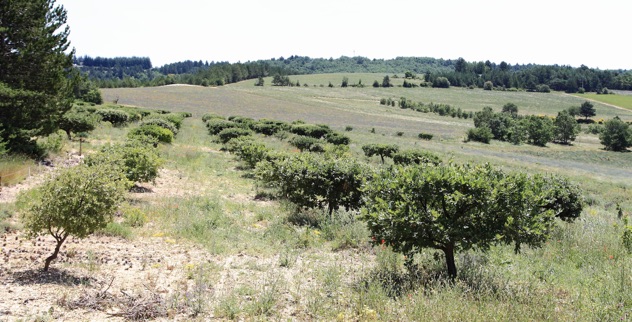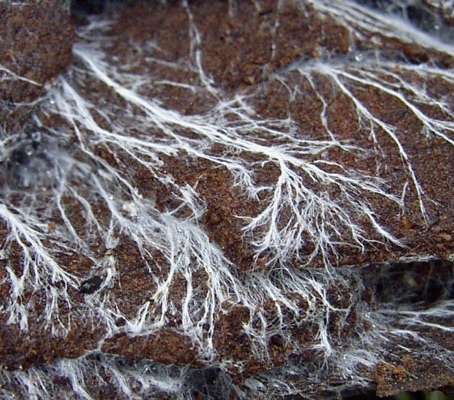News
26 June 2023
Fungi: friends or foes?
Mushrooms are generally known from two perspectives: on the one hand, they are highly appreciated food items, on the other, they may be toxic and sources of diseases (mycoses) for humans as well as for animals and plants. However, fungi have other important characteristics and functions, of which many are yet relatively poorly understood.

Truffle-field (plantation with oaks, hosts of truffles - Provence, France)
Mass and diversity of fungi
Let’s recall here that mushrooms account for a little less than 2% of the total living mass (biomass) of the Earth (equivalent of around 10 billion tons of carbon, compared to only 60 billion tons for humanity) [read]. They are characterized by a great diversity and comprise 5 to 10 million species (various estimates) of which only little more than 100,000 have been recorded and classified [read in French]. Fungi can be categorized in those pathogens that are parasites, saprophytes that feed on decaying organic matter (or plastic, for some), and mycorrhizal fungus [read in French].
Fungi in the soil and plant nutrition
Mycorrhizal fungi establish networks that connect plants and the soil. They contribute to increasing the surface of exchange between plants and the soil, and help them capture nutrients on a larger scale and more efficiently than what could be achieved only by roots. In exchange, plants give fungi elements such as sugars and vitamins [read in English and in French].
It was established that the presence of fungi helped improve the linkages between plants and their environment not just by facilitating soil-plant exchange of nutrients and water absorption by plants, but also by enhancing plant resistance to stress (pathogens, excessive salt, shortage of water) and plant tolerance to pollutants [read in French]. This association is similar to that between humans and microorganisms that make up the microbiota found inside their bowels.
Some specialized private firms working in close collaboration with universities and research centres have developed products made of fungus mixtures adapted to some plants and the conditions in which they live, and they boast achieving very impressive yields increases. These products are sold as granules, powders or liquid solutions that can be used by farmers to boost the plant - fungus association in the soil [read here in English and here in French].
Besides, research indicates that fungi played a key role in the colonization of emerged lands by plants [read].
Fungus and soil carbon cycle
Fungi play a determining part in the cycle of organic matter (and therefore of carbon in the soil). A recent study estimated for the first time the volume of CO2 equivalent transferred annually by terrestrial plants to the underground mycorrhizal mycelium at more than 13 billion tonnes [read]. This considerable amount corresponds to about one third of anthropogenic GHG emissions and illustrates the central importance of fungi in the environment. During the approximately 450 million years of their existence, fungi have had a fundamental role in the tenfold decrease of the concentration of CO2 in the atmosphere. The absolute need to protect these crucial elements is quite evident at a point in time when the increase of anthropogenic CO2 in the atmosphere and its consequences are a threat to the survival of humanity.

Underground mycellium
Fungi and other microorganisms in the soil: our essential potential allies
Another research shows that there is “an ocean of possibilities” to use the microbiota around plants - of which fungus are an important part - to improve plant health and resistance to diseases [read]. Its authors write that the use of pesticide and the genetic manipulation of plants are not sustainable solutions, particularly because they poison the environment and impact on soil biodiversity by reducing its volume and modifying its composition in terms of microorganisms [read here and here] and because they induce a resistance by adaptation of pathogens. This is all the more true as climate change increases stress situation for plants, making them less productive. In contrast, mechanisms have been observed that make the system made by plants and the microbiota to distinguish pathogens and parasites from symbiotic organisms. These mechanisms can, when required, trigger the plant immune system and a systemic defence against pests through the production of a multitude of biochemical interactions, some of which are hormonal.
These multiple mechanisms are, as yet, not well known, despite considerable progress, and they will need to be further researched in the future to tap their enormous potential and thus improve health and productivity of plants by relying on them rather than polluting the environment with synthetic chemicals that disrupt and weaken it. This will imply a need to change farming practices and abandon pesticides.
Conclusion
There is a growing awareness of the essential role of fungi in the nutrition and health of plants as well as in the soil carbon cycle. A better understanding of the mechanisms involved and their protection opens up huge possibilities for improving the sustainability of food production that could become, in the future, entirely independent of the use of toxic agrochemicals.
Fungi appear therefore not just as friends but as real allies of humanity in its pursuit of sustainable food.
————————————-
To know more:
-
•H-J Hawkins, et al., Mycorrhizal mycelium as a global carbon pool, Current Biology, 2023.
-
•Ali, S., Tyagi, A. et Bae, H., Plant Microbiome: An Ocean of Possibilities for Improving Disease Resistance in Plants. Microorganisms 2023,11,392.
-
•Rapp Learn J., Fungi Helped Kickstart the First Plant Life on Land, Discover, 2021.
-
•R.S. Meena et al., Impact of Agrochemicals on Soil Microbiota and Management: A Review, 2020, 9(2), 34, 2020.
-
•F. M. Martin, S. Uroz et D.G. Barker, Ancestral alliances: Plant mutualistic symbioses with fungi and bacteria, Science Vol. 356, No. 6340, 2017.
-
•Mycophyto, cultivons l’équilibre de la nature (online) (in French).
Selection of past articles on hungerexplained.org related to the topic:
Last update: June 2023
For your comments and reactions: hungerexpl@gmail.com


